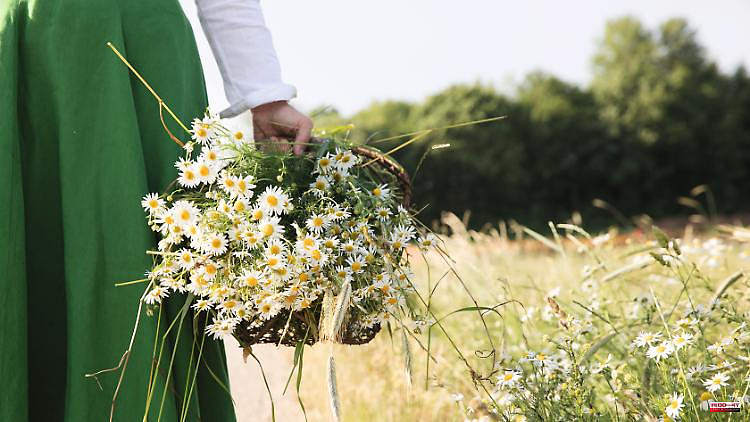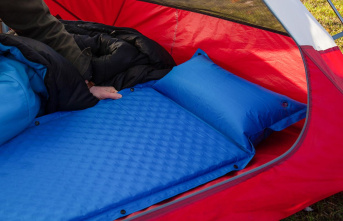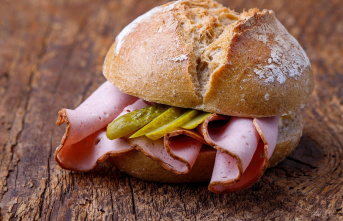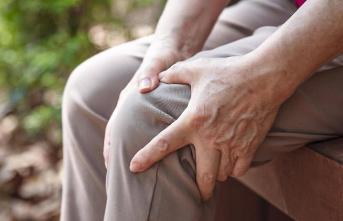Spring start with wild herb books: Brandstätter Verlag and Becker Joest Volk Verlag publish three wonderful nature books with lots of recipes, suggestions, stories and photos. In the truest sense of the word a "found food" for bookworms, greenery collectors and pot kieker.
The adventure begins at the front door. you say. Okay, you shouldn't take that to the nearest centimetre. When I've lifted myself down from my 8th floor in Berlin and step out the front door - I'm standing on flagstones. It's green all around, but the dogs only happily frolic through the bushes. I wouldn't collect anything there, let alone anything edible. And yet ... Even in big cities, not everything is concreted over, there are places with green oases, nut and fruit trees away from dog walking paths and busy roads. Berlin is also known for its many parks and green spaces. However, you should walk a few steps - or use public transport.
Authors write about all this - what, when, how, where edible greens grow and what they can be used for - in three highly recommended books: "Wild herbs - determining, collecting, preparing" (Martina Merz), "Found food - Recognizing, collecting and preparing wild ingredients" (Fabio Haebel, Jan Hrdlicka, Olaf Deharde and "Spring Awakening - Blossom Magic and Recipes from the Hazelnut House" (Theresa Baumgärtner).
Let's start with the book from which I stole the title: "Found food" from Brandstätter Verlag. The three friends Fabio, Olaf and Jan show that nature has many delicacies in store for us - not far away and at any time of the year. They show how we can find, recognize and collect wild ingredients in forests, rivers, meadows and along the way, how they are easily prepared or preserved. Where can I collect mushrooms and wild plants and how do I recognize them? Where can I (and all the other non-hunters and anglers) get quality meat and fish, what producers are there? "Found Fress" (there is also an Instagram channel for this) is an extensive cooking and reading book full of wild enjoyment and a love of nature, with grandiose dishes and basic recipes for drying, salting, fermenting, macerating and preserving, including a seasonal calendar and Collection guide for wild herbs and mushrooms. Exciting stories and impressive pictures about fishing, hunting, collecting and DIY inspire and encourage rethinking and a lasting change in our consumer behavior. "My friends Olaf, Fabio and Jan have managed to pack the versatility and special features of our nature as well as tasty recipes between two book covers," writes Tim Mälzer in the foreword.
The book is structured according to the four seasons: there are always stories and dishes, combined with advice, and interspersed with reports and food photos that arouse curiosity. The three men take us to the beach and the forest to collect, conveying a modern and contemporary approach to the topics of fishing and hunting. Texts and photos make you want to experience a Rügen weekend in spring, to spend summer days on the beach, to collect mushrooms in the autumn forest, to lean back in winter and enjoy the delicacies that have been preserved beforehand, or to discover surprises in the snow flurry that nature also has in the cold season.
Here's a little insight into the language of hunters so that those who don't know how to hunt, like me, don't take offense at passionate hunters. At least now I know what it's like "when the buck jumps on the leaf". Jan Hrdlicka explains why he decided to get a hunting license and that it's not that easy: "Although shooting and killing only make up about 1 percent of the hunt, the responsibility weighs heavily. In the meantime, I was closer to being a vegetarian than to being a vegetarian Jägers. (...) Of course it's more convenient to buy meat in the supermarket. Faced with pieces of meat without fur and eyes, it's - unfortunately - very easy to suppress the killing. But that doesn't mean that it doesn't take place." Sentences that make you think.
"Unfortunately, the perch is rarely found on menus in this country and is therefore a real angler's fish. It's a shame, we think, because it can definitely keep up with its big relative zander in terms of taste. Skinning is admittedly a bit 'fiddly', but With YouTube tutorials and a little practice, you can get it right. The turnips from the oven are ideal for a creamy and crispy bed. With a little spiciness and the acidity of the sorrel, this dish is not only simple, but also delicious."
Preparation:1. Preheat the oven to 240°C.
2. Peel the turnips and cut into fine slices. Place on a baking sheet lined with baking paper, brush with a little oil and salt.
3. Skin and fillet perch. Salt the fillets and sear on both sides in a hot pan with a little oil.
4. After about 15 minutes in the oven, the turnips are ready. Arrange the fillets on the turnips, garnish with finely chopped peppers and sorrel.
This comprehensive guide by Martina Merz, who is completely committed to sustainable nutrition and a life in harmony with nature, has been published by Becker Joest Volk Verlag. Since 2020 she has been sharing her knowledge on her YouTube channel "Edible Nature"; professionally, she advises producers, manufacturers and traders on organic products. Now, together with the BJVV, she is presenting her first, modern, almost 300-page standard work on wild herbs. In it, the author conveys the necessary background knowledge and practical tips in an easily understandable form in order to find one's way in the world of wild herbs and wild fruits. A perfect introduction to modern wild herb cuisine for beginners, but also for experienced collectors, in the country as well as in the city. In over 100 new vegetarian recipes, many vegan, lactose-free or gluten-free, Merz shows how you can easily and deliciously impress with wild herbs: Classics such as wild garlic, nettle, dandelion, sorrel, chickweed, elderberry and sloe as well as others are easily described found, but rather unknown plants, flowers and fruits. The result is delicious pestos, chutneys, pizzas, salads, pasta, pastries and smoothies. The dishes range from simple to sophisticated, from Alpine to Asian.
The book is divided into three parts: collect, prepare, determine. Merz gives tips for equipment and localities, draws attention to dangers, because after all some very poisonous and even deadly poisonous plants grow in Mother Nature. For this reason, the plants presented in words and pictures not only contain information on characteristics, locations, aromas and uses, but also on the mistaken partners. These can also be edible plants - and then everything is fine. But it could also be the poisonous doppelganger another time ... The extensive and detailed explanations are supplemented by infographics that have everything at a glance: from the harvest to the enjoyment factor. QR codes refer to walk videos in which Merz shows the respective plant in its original location or explains it in detail.
All too understandable that nobody likes to tuck the thick book under their arm on the collecting tours. This problem has been solved excellently by the author and publisher using QR codes: all plant portraits can be printed out as PDFs. When folded, the cards fit in any jacket pocket. Ideal especially for beginners!
"Making wild herb and wild flower butter yourself is very easy. You decide for yourself how salty, spicy or tender you want the butter to be, whether you only use one plant or a wild mixture. You can incorporate colored flowers like colorful confetti or use them to dye whole butter. It is important that you never heat the butter directly on the stove, but let it soften at room temperature, on the heater or in a warm water bath. You can fill prepared herb butter into glasses or shape it into a block or rolls, in Wrap in greaseproof paper and then refrigerate."
Preparation (time 10-15 minutes plus cooling time/resting time): Wash the herbs, spin dry and chop finely. Peel the garlic clove, chop very finely, sprinkle with a pinch of salt and crush with the back of a knife. Thoroughly mix soft butter, herbs, garlic, lemon juice and zest. Only at the very end season with the remaining salt and carefully fold in half of the blossoms. Form the finished herb butter, sprinkle with the remaining blossoms and press down. Refrigerate.
Tip: If you want to make a larger supply right away: Herb butter can be frozen in portions, for example in small silicone moulds. Wild fruits such as juniper are also great for processing in spiced butter.
Anyone who loves Theresa Baumgärtner's Christmas books will be happy to hold one of her magical books in their hands at a different time of the year. Like the number 1 in my review, "Frühlingserwaken" was published by Brandstädter Verlag and has regional and seasonal recipes from the beginning of spring to Midsummer festival. This book celebrates the reawakening of nature - with stories and poems, songs and of course lots of recipes. There is a playlist accompanying the book and a spring invitation to download and print. Atmospheric nature photos, funny illustrations alternate with food photos. Everything encourages imitation! Baumgärtner gives tips for lively flower arrangements, detailed handicraft instructions for flower garlands and wreaths and much more. The recipes range from soups and dips to vegetarian, fish and meat to heavenly desserts and cakes; Drinks, finger food and delicacies for the spring picnic are of course not missing either.
The author's lovingly written and designed Christmas books have been sold over 50,000 times - this spring book has what it takes. Born in Hamburg, she lives with her family in Luxembourg and is a successful author of cookbooks, writes and photographs as a columnist for magazines and works as a freelance presenter and author for television. In her guest house "Hazelnut House" in the east of Luxembourg, Baumgärtner organizes workshops on seasonal and regional cuisine as well as wonderfully romantic decorations. And the best thing is that it can also be done remotely: every Thursday evening at 9 p.m. on Instagram @hazelnut_house_1851 we can be there live.
Baumgärtner has structured her spring book thematically from the first tentative snowdrops to the bright red radiant corn poppies, from the awakening of nature and Easter to midsummer. The Swedish cinnamon rolls are a must for a hearty midsummer celebration. In the book you will not only find the recipe, but also instructions on how to skillfully wrap the cinnamon buns around your finger; also recipes for cold cucumber soup, Köttbullar, marinated salmon trout and strawberry tiramisu: Let the party begin!
Preparation: Place the flour and salt in a large bowl, mix and make a well in the middle. Crush the cardamom seeds in a mortar and add to the flour. Spread the butter in small knobs on the edge of the flour. Dissolve the yeast with the raw cane sugar in the milk, then stir in the egg yolk. Gradually add the yeast milk to the flour in the bowl and knead the ingredients into a smooth dough using a food processor or by hand. Cover the dough with a clean kitchen towel and let it rise in a warm place for 1 hour.
In the meantime, for the filling, mix the butter with the raw cane sugar, the cinnamon and the salt using a hand mixer. Line a baking sheet with parchment paper.
Dust the work surface with some flour. Knead the dough again in the bowl. Then roll out into a rectangle 3-5 mm thick and 18 cm wide. Divide the rectangle down the middle of the long side. Spread the soft cinnamon butter on one half with a knife and cover with the other half of the dough. Cut the 18 cm wide sheet of dough into twelve long, approx. 1.5 cm wide strips.
Wrap each strip three times around the middle three fingers. Carefully remove the ball, turn it 45 degrees and tie it around again three times like a ball of wool. Repeat rotating 45 degrees and wrapping until you have used up the strip of dough (see images below). Place the wrapped cinnamon buns on the baking sheet, cover with a clean kitchen towel and leave to rise for 1-2 hours.
In the meantime, preheat the oven to 200°C (circulating air). Place a small fireproof dish with water on the bottom of the oven. Brush the risen buns with the egg white. Squeeze an almond in the middle and/or sprinkle the buns with a few cardamom seeds. Bake in the middle of the hot oven for 20 minutes until golden. Spread the maple syrup over the cinnamon buns while they are still hot and leave to cool on a wire rack.
Equally important to all authors is the concern to strengthen our love of nature and our efforts to preserve it and to impart the necessary knowledge. The books contain addresses and sources, playlists and websites, QR codes, guides and various registers. Finally, three more recipes from the three books for you:
"A cozy evening around the campfire can hardly be topped. Unless a juicy ragout is simmering in a heavy pot over the fire and a bowl of yeast dough is ready for the first round of bread on a stick. This recipe always works - unless you're impatient. "
Preparation: 1. For the stick bread, mix the flour, yeast and salt well in a bowl. Slowly work the lukewarm water into the flour and finally add honey and oil. Knead until a smooth dough forms. Let the dough rise for 1 hour, then divide into 8 equal pieces. Shape into 8 balls of dough and leave to rise in the fridge overnight.
2. Start the ragout the next day: Cut the venison into small pieces, removing any unwanted tendons. Peel the parsley roots and onion and also cut into cubes.
3. Heat a large, heavy saucepan and melt the ghee in it.
4. Sear the venison gradually, then add the vegetables. When everything has taken on color, deglaze with a sip of red wine and loosen the toasted substances from the bottom of the pan with a wooden spoon. Add the rest of the red wine and the stock, season with salt. Put the lid on the pot and let the ragout simmer gently. Depending on the size of the pieces of meat, it takes about 1.5-3 hours until the meat is really tender.
5. When the ragout is almost done, shape the dough balls for the stick bread into rolls, turn them around a cleaned stick and bake them at a distance from the embers, turning them regularly so that they are golden brown on the outside and fluffy and well baked on the inside .
6. Remove the meat from the liquid and, if desired, let the liquid continue to boil uncovered until it is nice and creamy. Bind with cold butter or cornstarch, if desired. Add the meat back in and serve the ragout with stick bread.
"In summer I love lukewarm pasta with raw vegetables, lots of lemon and even more fresh herbs. You may be familiar with this with basil, but with freshly collected wild herbs it tastes completely different. I used to always fry zucchini, but now I use them but also very much raw, the vegetable is much firmer than cucumber and waters less."
Preparation: Wash the basil, shake dry and pluck off the leaves, but leave them whole. Wash cocktail tomatoes, cut in half (in the case of larger tomatoes, cut out the stalk and cut into eighths). Peel the garlic cloves, chop finely, salt and mash to a paste with the back of a knife.
Wash the wild herbs thoroughly, remove hard parts, set aside a few pretty leaves for decoration, and finely chop the rest.
Bring salted water to a boil in a large saucepan and cook the pasta according to package directions until al dente.
Meanwhile, wash the courgettes, grate them roughly into a large bowl or use a vegetable peeler to cut them into strips. Add chopped herbs and 1 tablespoon lemon juice and mix.
Halve and stone the avocado, scoop out the flesh with a spoon and cut into cubes.
Drain the cooked pasta, reserving the cooking water. It doesn't matter if the pasta cools down a bit, the pasta tastes even better lukewarm!
Add the zucchini-wild herb mixture, garlic, capers, 2 tbsp olive oil, a cup of pasta water, some salt and pepper to the pasta in the bowl and mix thoroughly.
Place on deep plates, top with the tomatoes, avocado and basil and gently fold in. Sprinkle with pecorino. Drizzle with the remaining lemon juice and olive oil and arrange nicely with the wild herbs you have set aside.
Tip: The summer pasta tastes just as good without zucchini and tomatoes, then simply use a little more lemon juice for the freshness flash. The avocado is also not a must, the pasta tastes very good without it!
PASTA TO GO: Can be prepared great as a lunch to go, but then I would use penne and only add fresh basil leaves and avocado right before eating.
Preparation: Wash the carrots, peel and cut into small cubes. Peel and fillet the oranges. Wash and quarter the apple, remove the core and dice the flesh. Peel and slice the ginger. Peel the pineapple, remove the stalk and cut the flesh into small pieces.
Put all the ingredients together in a high-performance blender and puree until smooth. Pass the juice through a sieve, pour into chilled glasses and serve with ice cubes, if desired.
Heidi Driesner wishes you a lot of fun and a magical spring.
(This article was first published on Thursday, April 28, 2022.)
6












